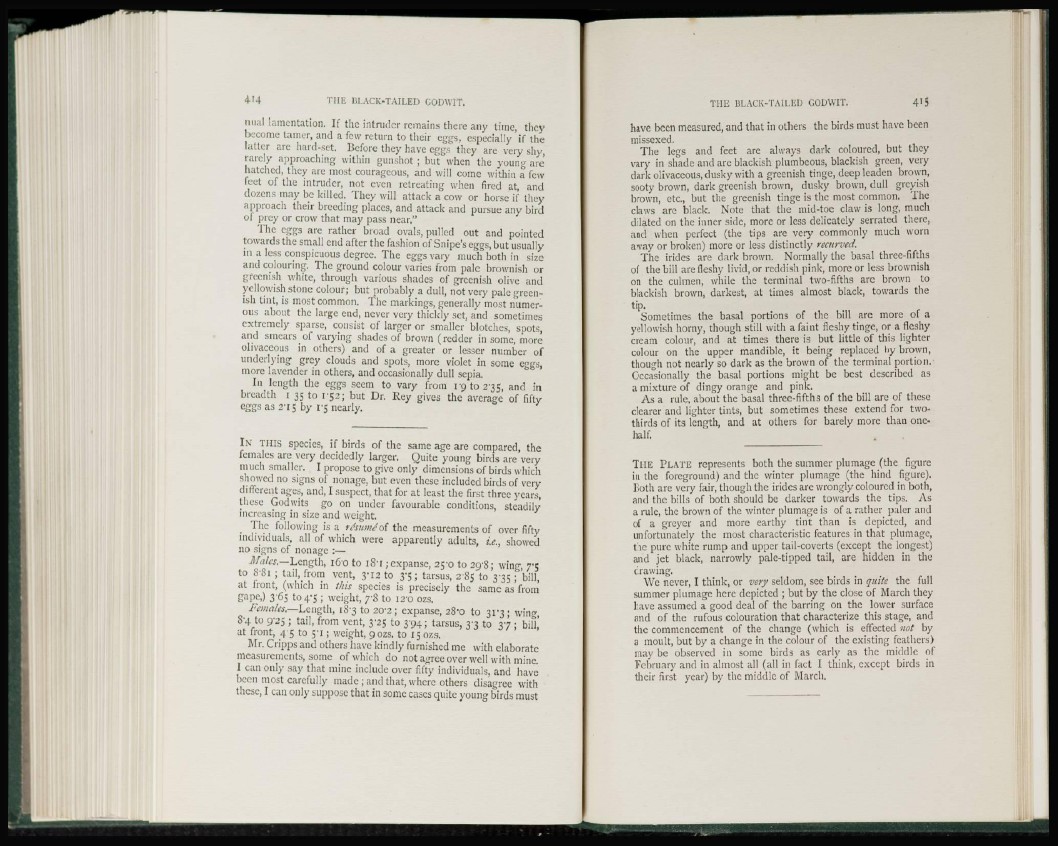
nual lamentation. If the intruder remains there any time, they
become tamer, and a few return to their eggs, especially if the
latter arc hard-set. Before they have eggs they are very shy,
rarely approaching within gunshot ; but when the young are
hatched, they are most courageous, and will come within a few
feet of the intruder, not even retreating when fired at, and
dozens may be killed. They will attack a cow or horse if they
approach their breeding places, and attack and pursue any bird
of prey or crow that may pass near."
The eggs are rather broad ovals, pulled out and pointed
towards the small end after the fashion of Snipe's eggs, but usually
in a less conspicuous degree. The eggs vary much both in size
and colouring. The ground colour varies from pale brownish or
greenish white, through various shades of greenish olive and
yellowish stone Colour; but probably a dull, not very pale greenish
tint, is most common. The markings, generally most numerous
about the large end, never very thickly set, and sometimes
extremely sparse, consist of larger or smaller blotches, spots,
and smears of varying shades of brown (redder in some, more
olivaceous in others) and of a greater or lesser number of
underlying grey clouds and spots, more violet in some eggs,
more lavender in others, and occasionally dull sepia.
In length the eggs seem to vary from i'9 to 2*35, and in
breadth 1 35 to 1*52; but Dr. Rey gives the average of fifty
eggs as 2*15 by V$ nearly.
IN THIS species, if birds of the same age are compared, the
females are very decidedly larger. Quite young birds are very
much smaller. I propose to give only dimensions of birds which
showed no signs of nonage, but even these included birds of very
different ages, and, I suspect, that for at least the first three years,
these Godwits go on under favourable conditions, steadily
increasing in size and weight.
The following is a r/sum/of the measurements of over fifty
individuals, all of which were apparently adults, £e.t showed
no signs of nonage :—
Males.—Length, 1C0 to iS'i j expanse, 25*0 to 20/8; wing, 7*5
to 8'8i ; tail, from vent, 3-12 to 3*5; tarsus, 285 to 3-35 ; bill,
at front, (which in this species is precisely the same as from
gape,) 365 to4-5 ; weight, 7-8 to 12*0 ozs.
Females.—Length, i8"3 to 20*2; expanse, 28'0 to 31*3; wing,
8"4 to 9/25 ; tail, from vent, 3*25 to 3-94; tarsus, 3'3 to 37 ; bill,
at front, 45 to 5*1 ; weight, 9 0 Z S . to 15 ozs.
Mr. Cripps and others have kindly furnished me with elaborate
measurements, some of which do not agree over well with mine.
1 can only say that mine include over fifty individuals, and have
been most carefully made ; and that, where others disagree with
these, I can only suppose that in some cases quite young birds must
have been measured, and that in others the birds must have been
missexed.
The legs and feet are always dark coloured, but they
vary in shade and are blackish plumbeous, blackish green, very
dark olivaceous, dusky with a greenish tinge, deep leaden brown,
sooty brown, dark greenish brown, dusky browrn, dull greyish
brown, etc., but the greenish tinge is the most common. The
claws arc black. Note that the mid-toe claw is long, much
dilated on the inner side, more or less delicately serrated there,
and when perfect (the tips are very commonly much worn
away or broken) more or less distinctly recurved.
The irides arc dark brown. Normally the basal three-fifths
of the bill are fleshy livid, or reddish pink, more or less brownish
on the culmen, while the terminal two-fifths are brown to
blackish brown, darkest, at times almost black, towards the
tip.
Sometimes the basal portions of the bill are more of a
yellowish horny, though still with a faint fleshy tinge, or a fleshy
cream colour, and at times there is but little of this lighter
colour on the upper mandible, it being replaced by brown,
though not nearly so dark as the brown of the terminal portion.
Occasionally the basal portions might be best described as
a mixture of dingy orange and pink.
As a rule, about the basal three-fifths of the bill arc of these
clearer and lighter tints, but sometimes these extend for twothirds
of its length, and at others for barely more than onehalf.
THE PLATE represents both the summer plumage (the figure
in the foreground) and the winter plumage (the hind figure).
Both arc very fair, though the irides are wrongly coloured in both,
and the bills of both should be darker towards the tips. As
a rule, the brown of the winter plumage is of a rather paler and
of a greyer and more earthy tint than is depicted, and
unfortunately the most characteristic features in that plumage,
the pure white rump and upper tail-coverts (except the longest)
and jet black, narrowly pale-tipped tail, are hidden in the
drawing.
We never, I think, or very seldom, see birds in quite the full
summer plumage here depicted ; but by the close of March they
have assumed a good deal of the barring on the lower surface
and of the rufous colouration that characterize this stage, and
the commencement of the change (which is effected not by
a moult, but by a change in the colour of the existing feathers)
may be observed in some birds as early as the middle of
February and in almost all (all in fact I think, except birds in
their first year) by the middle of March.